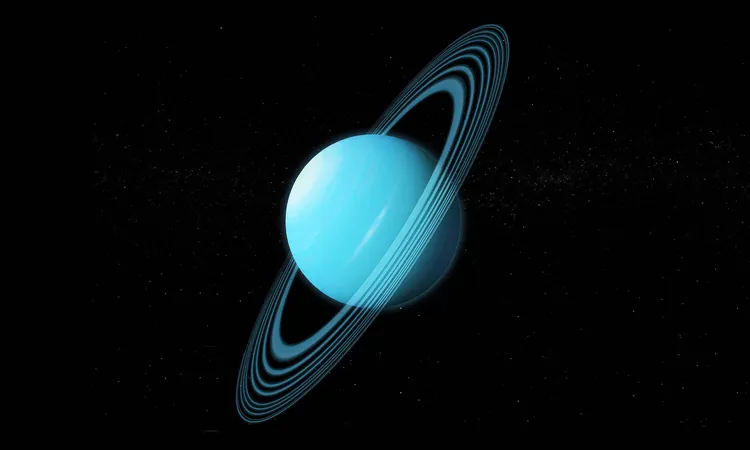
Unlocking the Secrets of Uranus: Voyager 2's Revelations After 40 Years!
2024-11-24
Author: Ken Lee
Understanding Uranus
Uranus, positioned as the seventh planet from the Sun, is notable for its extreme axial tilt of approximately 98 degrees, causing it to spin almost entirely on its side! This unique orientation results in bizarre seasonal changes, with each lasting over 20 Earth years. Uranus's striking blue-green color, a result of methane in its atmosphere, absorbs red light while reflecting blue, giving it a stunning appearance.
Home to a complex system of rings and 27 moons, Uranus’s satellites are predominantly named after Shakespearean characters, adding a literary flair to its celestial body. While its rings may not dazzle like Saturn’s, they are nonetheless fascinating in their own right, and the planet is renowned for harboring the coldest planetary atmosphere in our solar system, plunging to a frigid -224 degrees Celsius (-371 Fahrenheit). Completing an orbit around the Sun takes an astonishing 84 Earth years; in essence, a single year on Uranus spans nearly a lifetime for humans!
Voyager 2's Historic Encounter
Voyager 2 made its historic flyby of Uranus in 1986, marking the first and only close-up examination of this extraordinary planet. This iconic mission unveiled new moons and rings but also raised scientific questions that puzzled researchers for decades. Following a thorough re-evaluation of Voyager 2’s data, scientists have recently made exciting breakthroughs regarding Uranus’s magnetic field.
Mystifying Anomalies
Initially, the puzzle lay in the presence of energized particles surrounding Uranus. The planet's unique tilt and rotation challenged conventional theories surrounding how magnetic fields ensnare particle radiation. After re-examining historical data, researchers found that an unusual cosmic event prior to the Voyager 2 flyby may have drastically altered Uranus's magnetosphere.
Jamie Jasinski, a leading scientist at NASA's Jet Propulsion Laboratory and the principal author of a new study published in *Nature Astronomy*, noted, “The spacecraft saw Uranus in conditions that only occur about 4% of the time.” Had Voyager 2 arrived just days earlier, it would have captured a vastly different picture of the planet's magnetic environment.
Unraveling the Magnetosphere Mysteries
The magnetosphere of Uranus plays a crucial role in how the planet interacts with solar winds and cosmic rays. Earth's magnetosphere protects us from harmful solar radiation, and understanding Uranus's magnetosphere is vital for comprehending how other celestial bodies in our solar system behave.
Intriguingly, the Voyager 2 data revealed a remarkable intensity of electron radiation belts surrounding Uranus, surpassed only by those of Jupiter. This anomaly presented a pressing question: if Uranus's moons were thought to be inactive, where was this intense radiation originating?
The Role of Solar Wind
Recent analysis suggests that solar wind played a pivotal role in shaping the planet's magnetosphere. The compressive forces from solar wind substantially altered Uranus's magnetic field configuration, potentially driving plasma out of the system and thereby enabling the creation of its radiation belts.
Researchers now hypothesize that Uranus's five major moons, previously considered inactive, might indeed possess geological activity, continuously contributing ions into the magnetosphere. This could fundamentally change our understanding of these celestial bodies.
Looking Ahead: Future Exploration of Uranus
The National Academies’ 2023 Planetary Science and Astrobiology Decadal Survey emphasizes the importance of Uranus as a priority for upcoming NASA missions. Linda Spilker from JPL, who worked on the original Voyager 2 mission, remarked on the surprises the flyby brought: "This new work explains some apparent contradictions and will significantly change our view of Uranus."
The Voyager 2 Legacy
Despite being billions of miles away, Voyager 2 remains an active source of scientific discovery, continually transmitting data about the interstellar medium through NASA’s Deep Space Network. It is expected to send back information until at least 2025, serving as a testament to human ingenuity and the relentless pursuit of knowledge.
With every revelation, our understanding of Uranus deepens, compelling future explorers to venture into the great unknown, driven by the tantalizing enigmas of our solar system. Stay tuned for more discoveries in the years to come!


 Brasil (PT)
Brasil (PT)
 Canada (EN)
Canada (EN)
 Chile (ES)
Chile (ES)
 España (ES)
España (ES)
 France (FR)
France (FR)
 Hong Kong (EN)
Hong Kong (EN)
 Italia (IT)
Italia (IT)
 日本 (JA)
日本 (JA)
 Magyarország (HU)
Magyarország (HU)
 Norge (NO)
Norge (NO)
 Polska (PL)
Polska (PL)
 Schweiz (DE)
Schweiz (DE)
 Singapore (EN)
Singapore (EN)
 Sverige (SV)
Sverige (SV)
 Suomi (FI)
Suomi (FI)
 Türkiye (TR)
Türkiye (TR)